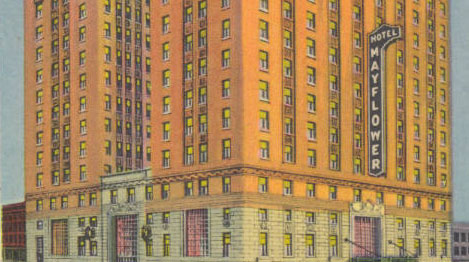A Place of Contrasts
The Mayflower Hotel stands among downtown Akron’s other buildings. From its popularity in the 1930s to its downfall in the 1960s, the Mayflower Hotel–now renamed the Mayflower Manor–has seen many changes. What was once a prominent location for local socializing is now housing to low-income residents and people with disabilities in the city of Akron. However, in the past, it was a famous location where stars such as George Maharis, Martin Milner, and Shirley Temple stayed. It is the place where, at the telephone in the lobby, Bill Wilson made a call that connected with Henrietta Seiberling, which eventually led to the creation of Alcoholics Anonymous. This phone can still be found in the hotel lobby.

Before the famous Mayflower Hotel was alive, a YMCA stood in its place. “The five-story building opened in 1906” and included several activity rooms, a swimming pool, and a dormitory. In 1931, the building outgrew its facilities, and a larger one was constructed. The original building was razed to make way for the Mayflower Hotel. Interestingly, the Mayflower was built during what was named “Akron’s Building Boom,” which took place during the Great Depression.1

Significant Beginnings and Rubber Balls
Flowers floated down from the sky on May 18, 1931, when the Mayflower Hotel celebrated its grand opening. The stunning hotel was sixteen stories high and had 450 rooms. Designed by the firm Graham, Anderson, Probst & White, the hotel included a bar, dining room, lounge, and spacious guest rooms with individual bathrooms.6

On Mother’s Day in 1935, the first steps to the formation of Alcoholics Anonymous were taken in the lobby of the Mayflower Hotel. Bill Wilson made a call from the lobby phone using a church directory to St. Paul’s Episcopal rector, claiming to have an issue with alcohol. He was connected to a high-standing woman by the name of Henrietta Seiberling. A couple days later, Seiberling received a phone call from Bob Smith, as well. Both men were struggling with alcohol and looked towards Seiberling to guide them through a spiritual healing process. After that day, the wheels began turning and eventually led to the formation of Alcoholics Anonymous.2
Along with the start to foundation of Alcoholics Anonymous and the grand opening of the Mayflower, the citizens of Akron had others things to celebrate. The Mayflower Hotel hosted the annual Rubber Ball party, which 1,800 people attended. In 1938, the people were required to wear costumes made out of rubber, and a king and queen were crowned.3

Changing Themes
The end of World War II in 1945 brought celebrations for everyone, including the Mayflower Hotel. During this time, its function was still in full swing. The hotel had a tradition starting when it opened to occasionally change its dining room to a new theme. In the 1940s, they chose to change it from a Hawaiian theme to Terrace, which they saw as a more elegant theme.
In 1956, the staff once again transformed their dining room to represent the “Merry Man.” This was a written manuscript by P. P. Cherry about the Western Reserve and early Ohio. Little did the Mayflower know, this would be the last theme they would show before closing.

Highs and Lows
The Mayflower Hotel hit both its highest and lowest points during the 1960s. In 1961, George Maharis and Martin Milner came to Akron for the twenty-fourth All-American Soapbox Derby. They, along with the soapbox racers and other celebrities, found the Mayflower to be the perfect place to stay. Starstruck fans would call the hotel in hopes of getting patched through to the gentlemen, some of which succeeded.4

Later in the 1960s, however, the Mayflower was no longer the place to be. The surroundings came to be considered unsafe, and the hotel itself was linked to prostitution.
Sadly, the downfall during the 1960s caused the Mayflower to take a huge hit. The Mayflower shut down in 1971, the first time the doors had been locked in 40 years.
The Mayflower Hotel remained locked until the 1980s, when it became a senior living center for low-income residents and people with disabilities. It has remained like this, even to the present day.

A Historic Building
In 2008, the Mayflower Hotel was listed on the National Register of Historic Places. It is now known by its new name, Mayflower Manor. To this day, 233 rooms are used as housing. Although it may feel like a downfall in contrast to the glamour of its glory days, the Mayflower has become a haven for people with needs to live independently and with purpose.

Researched and written by Jamie Dombroski, Katie McGormley, and Kassandra Skelly
- Blyth, Raymond. “Y.M.C.A.” Summit Memory. J. Bouton & Co. Inc., February 26, 2008. https://www.summitmemory.org/digital/collection/clinefelter/id/572/rec/7.
- Canterbury, William. “Henrietta Seiberling Dies at 91.” Akron Beacon Journal. December 1979.
- Harris, Sheryl. “Akron Elite Sport Hot Rubber Fashions at Dance.” The Beacon Journal. June 8, 1997.
- Price, Mark J. “Route 66′ Stars Rolled Into Akron.” Akron Beacon Journal. July 2016.
- Nichols, Ken. “Mayflower Born Again.” Beacon Journal. May 1981.
- Studios, Inc., Charles Mayer. “Sheraton Hotel.” Summit Memory. Akron-Summit County Public Library, August 27, 2008. https://www.summitmemory.org/digital/collection/clinefelter/id/580/rec/101.
